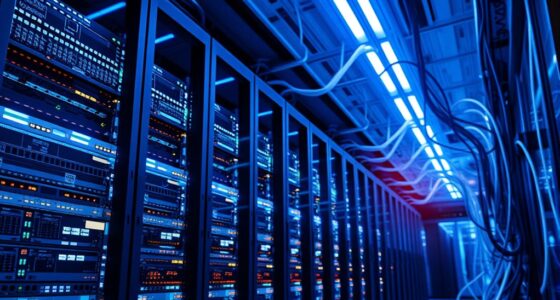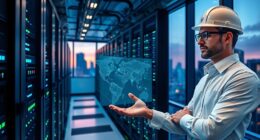Edge, cloud, and fog computing each serve different needs in data processing. Edge brings processing closer to devices, enabling quick responses and low latency but poses security challenges. Cloud offers powerful centralized processing but might introduce delays and security concerns during data transfer. Fog acts as a middle ground, linking edge and cloud to balance real-time actions and complex analysis. Understanding these differences helps you choose the right approach—discover more about how each fits your needs.
Key Takeaways
- Edge computing processes data locally near devices for real-time responses with low latency.
- Cloud computing centralizes data in large data centers for heavy processing and long-term storage.
- Fog computing acts as a hybrid layer, extending cloud capabilities closer to the data source.
- Security challenges vary, requiring tailored protections for edge devices, fog layers, and cloud infrastructure.
- Choosing between them depends on latency needs, processing complexity, and security considerations.

Have you ever wondered where your data is processed when you use smart devices or IoT applications? It’s a question that becomes more important as these devices become more integrated into your daily life. The answer depends on the computing approach used—edge, cloud, or fog computing. Each has its strengths and challenges, especially when it comes to handling real-time data and security challenges. Understanding these differences can help you make smarter choices about how your data is managed and protected.
Edge computing brings processing closer to the source of data—your smart devices or sensors—so that data doesn’t need to travel far to be analyzed. This setup is ideal for real-time data processing because it reduces latency considerably. When an IoT device detects an immediate event, like a security camera noticing motion or a sensor sensing a leak, edge computing allows for instant responses. However, processing data locally also presents security challenges. Because sensitive data is stored and processed at or near the device, it becomes a tempting target for cyberattacks. Ensuring robust security measures at each edge device is essential but often complex, especially when dealing with a vast network of diverse devices. Additionally, managing updates and security patches across numerous edge devices can be resource-intensive and challenging.
Edge processing reduces latency but requires strong security for diverse, localized devices.
Cloud computing, on the other hand, channels data to centralized data centers for processing and storage. This approach is powerful for handling large volumes of data and performing heavy computations that devices can’t handle alone. The cloud excels at long-term data analysis, machine learning, and storage, making it invaluable for many applications. However, when it comes to real-time data, cloud computing can introduce latency because data must traverse the internet to reach the data center and back. This delay can be problematic in situations requiring immediate action. Security challenges in the cloud involve protecting transmitted data and securing the cloud infrastructure itself. Data breaches and unauthorized access are ongoing concerns, demanding continuous security upgrades and compliance measures. Proper encryption and access controls are essential to safeguard sensitive information stored or processed remotely.
Fog computing acts as a bridge between edge and cloud processing. It extends the cloud’s capabilities closer to the data source—typically on local servers or gateways—so that some processing happens locally while heavier tasks are delegated to the cloud. This hybrid approach helps balance real-time processing needs with the capacity for complex analysis. It also helps mitigate security challenges by keeping sensitive data closer to the source, reducing exposure during transmission. Still, fog computing isn’t immune to security issues; it requires careful management to prevent vulnerabilities in the intermediate layers. Effective security protocols are vital to protect data and maintain system integrity across all layers.
Frequently Asked Questions
How Do Latency Differences Impact Each Computing Model?
You’ll notice that lower latency in edge and fog computing helps with real-time processing, reducing delays for critical tasks. Cloud computing often has higher latency, which can hinder immediate responses. To mitigate latency issues, you should choose edge or fog solutions for time-sensitive applications, ensuring faster data processing and better performance. This way, you get quicker insights and more effective real-time decision-making, especially where milliseconds matter.
What Security Challenges Are Unique to Each Computing Approach?
Ironically, your biggest security challenge isn’t just hacking but trusting that your device vulnerabilities are sealed. With edge computing, you face data privacy issues because data is processed locally, increasing exposure. Cloud computing risks include large-scale breaches due to centralized data storage. Fog computing combines both, so you must guard against vulnerabilities across devices and network nodes, making security a constant, nuanced battle rather than a one-time fix.
Which Model Offers the Best Scalability for Large Networks?
You’ll find that cloud computing offers the best scalability for large networks because its centralized architecture easily adapts to changing network topology and handles data integration across extensive systems. Cloud services provide flexible resource allocation, making it simple to expand or reduce capacity as needed. This model effectively manages large data volumes, ensuring seamless integration and communication across diverse network devices and locations, unlike more decentralized approaches.
How Do Costs Compare Across Edge, Cloud, and Fog?
You’ll find that costs vary based on your needs. Cloud computing generally offers cost efficiency for large-scale, flexible resources, but it involves higher ongoing investment requirements for data transfer and storage. Edge computing can reduce ongoing costs by processing data locally, saving bandwidth, but requires significant upfront investment in hardware. Fog computing balances both, with moderate costs and investment needs, making it adaptable for diverse applications.
What Are the Best Use Cases for Each Computing Type?
Think of IoT devices as the busy bees gathering nectar—each computing type has its sweet spot. Use edge computing to process data analytics right at the source, perfect for real-time decisions like autonomous vehicles. Cloud computing acts as a vast library for deep analysis and storage, ideal for large-scale data. Fog computing bridges the gap, handling intermediate tasks like smart city infrastructure management. Choose based on your speed, scale, and complexity needs.
Conclusion
In the race to manage data effectively, understanding the strengths of edge, cloud, and fog computing helps you choose the right strategy. Think of it as assembling your own tech Avengers team—each has its moment to shine. While cloud offers vast power, edge provides instant action, and fog bridges the gap. Remember, even in a world still waiting for flying cars, selecting the right approach keeps your tech game ahead of the 21st century.









